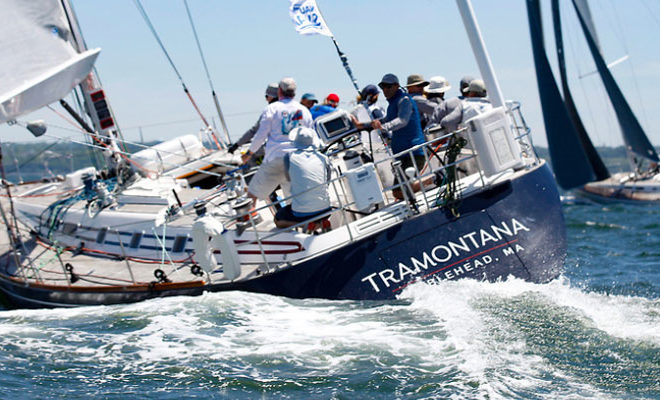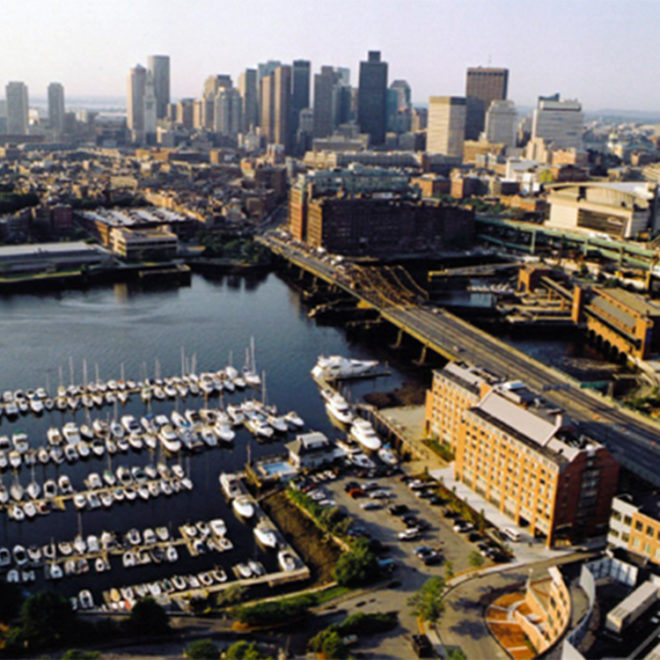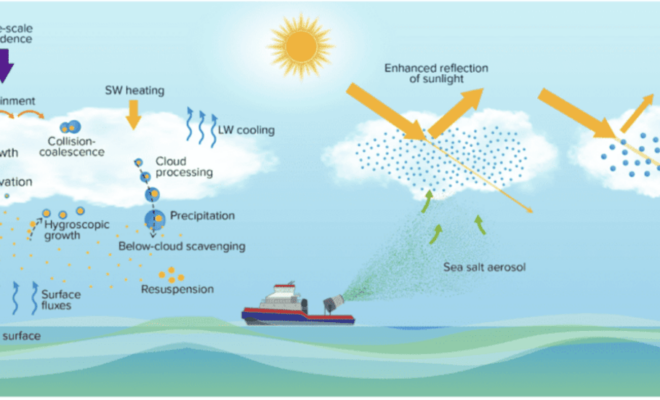Phillips Point, 3.5 miles southwestward of Marblehead Light, is 50 feet high and rocky with woods and large homes along its shore. A rock ledge covered 12 feet is 600 yards eastward of Littles Point, the eastern part of Phillips Point. A fishing net extends eastward from Littles Point during the summer. A reef with bare heads extends 350 yards southward from Phillips Point. Dread Ledge, 500 yards southward of the point, uncovers 5 feet and is marked by a daybeacon.
Nahant Bay is 2 miles wide between Phillips Point and Nahant. Temporary anchorage, exposed to easterly and southerly winds, can be had in the bay in 18 to 36 feet but is seldom used. The usual anchorage is off Swampscott, northwestward of Lincoln House Point. Many small craft moor here in the summer. Several mooring buoys, used by local craft, are in the cove westward of the point, off Fishermans Beach. A 440-foot pier with 50 feet of floats at the end extends off the beach; there are depths of 5 feet at the floats, but no services. The Swampscott Yacht Club is at the shore end of the pier. A harbormaster, who maintains an office at the yacht club, supervises the moorings.
There is a public small-boat ramp with parking space adjoining the pier. Water and guest moorings are available. Gasoline can be obtained in cans from a nearby service station. Ice, provisions and marine supplies are available from the nearby markets and stores.
Nahant Bay is mostly clear. Lincoln House (Fishing) Point, Blaney Rock and Red Rock are rocky points on the northern side of Nahant Bay. A dangerous submerged rock, marked on its south side by a buoy, is about 125 yards south of Lincoln House Point. Two other rocks, covered 16 feet and 18 feet, are about 400 yards southward and about 700 yards south-southwestward of Lincoln House Point, respectively.
The town of Swampscott is on the northern shore of Nahant Bay. A large blue standpipe and the school cupola are conspicuous. A church spire, lighted at night, on the shore drive at Red Rock, and an observatory, about 0.9 mile northwestward of Red Rock, are also prominent.
Long Beach is a narrow strip of sand about 1 mile long in a southerly direction separating Nahant Bay from Lynn Harbor. Little Nahant, a high grassy head with many houses, is joined to Nahant by Short Beach, a strip of beach 0.4 mile long. The white buildings and signal tower of the former Coast Guard station on Short Beach are just southward of Little Nahant.
Egg Rock, 60 feet high and bare, is on the southern side of the entrance to Nahant Bay. It is a bird sanctuary.
Nahant is a high peninsula about 1.5 miles long with bluff seaward faces. The town of Nahant is connected to Lynn by a highway. Among the most prominent objects are four nearly identical concrete observation towers; two are on the outer end of the peninsula just north of Pea Island, one is about 0.4 mile to the northward, and the fourth is on the west side of the harbor. The top section of the southerly of the two towers just north of Pea Island is topped with a wind break painted red and reportedly is especially prominent. A former military installation, now used by Northeastern University as a marine research facility, is on East Point, the easternmost point of the peninsula. A 60-foot windmill on East Point is reported to be prominent.
Nahant Harbor is the bight on the south side of Nahant. On entering between Joe Beach Ledge, covered 3 feet and marked by a buoy, and The Spindle (Bass Rock), awash and marked by a buoy, select temporary anchorage off the wharf in 18 to 24 feet, hard bottom. The town wharf on the east shore at the head has about 6 feet alongside the float landing; a hard-surface launching ramp for small boats is on the north side of the shore end of the wharf. Water is available at the float. There is a sailing club on the wharf, and a harbormaster controls the moorings. The Boston pilot boats land and pick up pilots at this wharf and maintain a mooring off the wharf.
Shag Rocks are bare rocks extending 300 yards southward from the southeast end of Nahant. A ledge, awash at lowest tides, extends 100 yards southward from the southernmost Shag Rock. A lighted buoy is south of the ledge.
Broad Sound, about 4 miles wide between Nahant on the northeast and Deer Island on the southwest, forms the approach to Nahant and the city of Lynn at its north end, and the northern approach to Boston Harbor at its south end. It has depths of 18 to 48 feet in the entrance but is shoal near the shores. A foul area with submerged rocks, some covered ½ foot, is offshore on the west side of the sound, about 0.9 mile east-northeast of the tower at Revere Beach. Pilings, awash and unmarked, about 300 yards northeastward of the foul area, are in 42°25’09″N., 70°57’48″W.
Lynn Harbor, the northerly end of Broad Sound, is mostly sand and mudflats that largely bare at low water and through which a channel has been dredged to the city of Lynn, an industrial community of major importance. In 1979, it had little waterborne commerce. Of the many diversified industries, a large General Electric plant, which manufactures airplane engines and electronic products, is the largest employer. In 1979, several of the wharves were being used as marinas, and the remainder were not in general use or were in ruins or disrepair.
Prominent features:
Landmarks in approaching Lynn Harbor are the standpipe on Winthrop Head, two apartment houses on Winthrop Highlands, the observation towers at Nahant, a white tank at the head of the harbor, and the radio towers on the Saugus River and the Pines River.
Channels:
A dredged channel leads from Broad Sound, at a point about 0.8 mile westward of Bass Point, to a turning basin at the head of Lynn Harbor. A privately maintained subsidiary channel leads from the basin in a southwesterly direction to the wharf of a powerplant.
Black Rock Channel, a branch channel leading along the western side of Nahant, is unmarked and suitable only for small craft. Sand flats, bare or nearly bare at low water, are on each side. In 1979, it was reported that the channel had shoaled to 5 feet but that it was still being used by lobstermen and small craft.
Western Channel, westward of the main channel to Lynn Harbor, leads from Broad Sound to the General Edwards Bridge and the Saugus River. Pines River is entered from Saugus River just westward of the bridge.
Western Channel is marked by buoys to just below the General Edwards Bridge. Dangerous rocks awash, on the northern side of the channel, extend about 200 yards south-southeastward from a point on the north shore about 200 yards below the General Edwards Bridge; the southern extremity of the rocks is marked by a buoy. Above the bridge, the channel is unmarked and local knowledge is advised.
Anchorages:
Small craft moor off the marina and boatyard north of Bass Point and eastward of the turning basin at the head of Lynn Harbor. In Saugus River, some moor off the yacht club close eastward of General Edwards Bridge. Above the bridge they moor on the west side of the channel and above Fox Hill Bridge in the channel wherever space permits. In Pines River they moor in the narrow channel. Moorings are under control and supervision of the harbormaster, who can be contacted through the local police department. Depths in the anchorages are off Bass Point from 5 to 30 feet, at the head of Lynn Harbor from 7 to 17 feet, and in Saugus and Pines Rivers from 3 to 9 feet.
Some local knowledge or assistance will be needed in finding swinging room or a vacant mooring off the yacht clubs at the head of Lynn Harbor, as this area is usually heavily congested with small craft.
Many small craft moor on the east side of the harbor near Bass Point, and the boatyard there maintains about 150 moorings, with usually a few vacant.
Dangers:
The principal dangers in the approach to Lynn Harbor are Flip Rock, covered 13 feet and marked by a gong buoy, 0.6 mile south of The Spindle; Nahant Rock, covered 19 feet and marked by a buoy, 0.8 mile southwest of Bass Point; and two unmarked shoals, covered 14 and 18 feet, about 0.7 mile northward of Nahant Rock.
Current:
The average velocity at strength of the tidal current at Lynn Harbor entrance is 0.5 knot.
Harbormasters:
There is a harbormaster at Lynn and one at Saugus. The former can be contacted through the Volunteer Yacht Club at Lynn; the latter through the Saugus Police Department. They supervise and control the moorings.
Wharves:
In 1979, only the wharf of the General Electric plant on Saugus River was in periodic use. Depths of 9 feet were reported alongside. A development plan for the greater use of the Lynn waterfront was being implemented in 1979.
Supplies and repairs:
There are no bunkering facilities, drydocks, or major repair facilities for large vessels at Lynn. The nearest drydocks or repair facilities for large vessels are at Boston. Marine supplies, provisions and machine shops are available in the city.
Small-craft facilities:
There are several marinas, boatyards, and private yacht clubs at Lynn and on the Saugus and Pines Rivers. Most of these facilities have gasoline, marine supplies, storage and berthing facilities, water, ice and launching ramps. The facilities on Pines River can make hull and engine repairs; an 18-ton mobile hoist and a 50-foot marine railway are available. Pump-out facilities are available at Seaport Landing Marina at the head of Lynn Harbor and at Revere through the harbormaster.
The yacht clubs include the Bass Point Boat Club, on Bass Point; the Lynn and Volunteer Yacht Clubs at the head of the harbor; the Point of Pines Yacht Club, on the south side of Saugus River, just eastward of the General Edwards Bridge; the Fox Hill Yacht Club, near the Fox Hill Bridge; and the Saugus River Yacht Club, about 0.7 mile above the Fox Hill Bridge. The clubs all have berthing facilities, guest moorings and other services available to members and guests.
Lynn has railroad and bus services, a hospital, hotels, banks, churches and many other conveniences.






